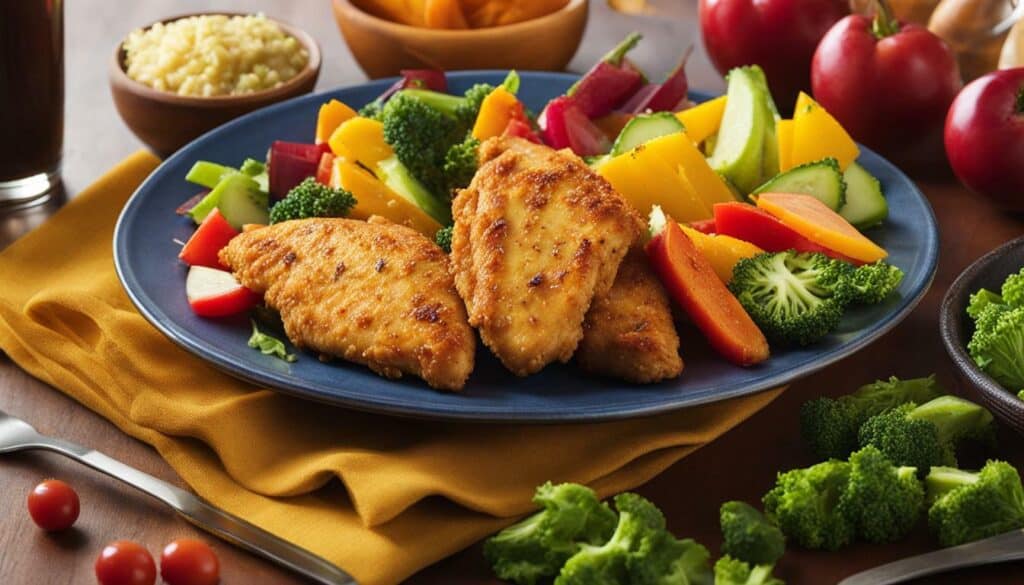Are you curious about the caloric content of 5 chicken tenders? In this guide, I will provide you with all the information you need to know about the nutritional composition of this popular food choice. Whether you’re watching your calorie intake or simply want to make informed choices about your dietary habits, understanding the caloric content of chicken tenders is essential.
When it comes to fried chicken tenders, it’s important to note that they typically contain high amounts of fat and sodium. According to the USDA, a single serving of fast-food chicken tenders packs a punch with 499 calories, 25.7g of fat, and 1410mg of sodium. Additionally, it contains 31.7g of carbohydrates, 2.2g of fiber, 0.7g of sugars, and 35.4g of protein.
However, it’s worth mentioning that the caloric content and nutrient composition can vary between different brands and types of chicken tenders. So, it’s always a good idea to check the specific nutritional facts for the product you’re consuming.
If you’re looking for a healthier alternative to fried chicken tenders, consider baking them instead. By using boneless, skinless chicken breast, you can significantly reduce the fat content while still enjoying a tasty meal. This cooking method also helps retain the natural flavors and juiciness of the chicken.
Remember that proper handling and storage of raw and cooked chicken are crucial to prevent foodborne illnesses. Make sure to follow food safety guidelines and cook chicken thoroughly to ensure it’s safe to consume.
In summary, understanding the caloric content and nutritional composition of chicken tenders can help you make informed choices about your dietary intake. Whether you choose to indulge in fried chicken tenders or opt for healthier baked alternatives, being aware of the nutritional facts empowers you to take control of your diet.
Key Takeaways:
- Chicken tenders, particularly fried ones, are typically high in fat and sodium.
- A single serving of fast-food chicken tenders can contain 499 calories, 25.7g of fat, and 1410mg of sodium.
- Different brands and types of chicken tenders can have varying calorie and nutrient content.
- Baking chicken tenders using boneless, skinless chicken breast is a healthier option that reduces fat content.
- Proper handling and storage of chicken are essential to prevent foodborne illnesses.
When it comes to chicken tenders, understanding the caloric content is crucial for managing your dietary intake. Let’s delve into the specifics.
Fried chicken tenders, a popular fast-food option, are typically high in fat and sodium. According to the USDA, a single serving of fast-food chicken tenders contains approximately 499 calories, 25.7g of fat, 1410mg of sodium, 31.7g of carbohydrates, 2.2g of fiber, 0.7g of sugars, and 35.4g of protein.
However, it’s important to note that the calorie and nutrient content of chicken tenders can vary depending on the brand and type. Different cooking methods, batter variations, and portion sizes can all affect the overall nutritional composition.
Variations in Caloric Content and Nutrients
To provide more insight, here’s a breakdown of the calorie content of 5 chicken tenders from different popular fast-food chains.
As you can see, there can be significant variations in the caloric content of chicken tenders depending on where you get them. It’s always a good idea to check the nutritional information provided by the specific brand or restaurant.
For those looking for a healthier alternative, consider baking chicken tenders instead of frying them. By using boneless, skinless chicken breast and a light coating, you can reduce the fat content while still enjoying the delicious taste.
Remember, proper handling and storage of raw and cooked chicken is crucial to prevent foodborne illnesses. Be sure to follow safe food practices to keep yourself and your loved ones healthy.

By understanding the caloric content and nutritional composition of chicken tenders, you can make informed choices about your dietary intake. Whether you opt for the occasional indulgence or choose healthier alternatives, knowledge is empowering when it comes to managing your health and well-being.
Summary
- Chicken tenders can be high in calories, fat, and sodium when fried.
- The calorie content of chicken tenders can vary depending on the brand and cooking method.
- Baking chicken tenders using boneless, skinless chicken breast is a healthier alternative to frying.
- Proper handling and storage of raw and cooked chicken is essential to prevent foodborne illnesses.
- Understanding the nutritional composition of chicken tenders allows you to make informed choices about your diet.
Nutritional Facts of Fried Chicken Tenders
According to the USDA, a single serving of fried chicken tenders contains approximately 499 calories and significant amounts of fat and sodium. Let’s take a closer look at the nutritional breakdown.
| Nutrient | Amount per Serving |
|---|---|
| Calories | 499 |
| Fat | 25.7g |
| Sodium | 1410mg |
| Carbohydrates | 31.7g |
| Fiber | 2.2g |
| Sugars | 0.7g |
| Protein | 35.4g |
As seen from the nutritional facts, fried chicken tenders are high in calories and fat. The sodium content is also quite substantial, which can be a concern for individuals watching their sodium intake. While chicken tenders can be a tasty treat, it’s important to enjoy them in moderation due to their nutritional composition.
It’s worth noting that different brands and types of chicken tenders may have varying calorie and nutrient content. Therefore, it’s essential to check the nutritional information on the packaging or inquire with the restaurant to make informed choices.
For those looking for healthier alternatives, consider baking chicken tenders instead of frying them. By using boneless, skinless chicken breast, you can reduce the fat content while still enjoying the delicious taste of tender chicken. Baking also helps retain more of the natural flavors and nutrients, making it a healthier option overall.
Proper handling and storage of raw and cooked chicken is crucial to prevent foodborne illnesses. Always ensure that chicken is cooked thoroughly and stored at the proper temperature to minimize the risk of contamination.
Understanding the nutritional composition of chicken tenders allows individuals to make informed choices about their dietary intake. By considering the caloric content and nutrient values, one can incorporate chicken tenders into their diet more consciously and maintain a balanced eating plan.

Please note that the nutritional information provided here is for reference purposes only and may vary depending on the specific brand, cooking method, and serving size.
It’s important to note that the caloric content and nutritional value of chicken tenders can vary depending on the brand and type you choose. Let’s explore these variations.
When it comes to the caloric content of chicken tenders, it’s essential to pay attention to serving sizes and preparation methods. Different brands may have different portion sizes, which can significantly impact the overall calorie count. For example, a single serving of fast-food chicken tenders, according to USDA data, contains 499 calories. However, other brands may have smaller portions, resulting in fewer calories per serving.
Additionally, the nutritional composition of chicken tenders can vary. While the aforementioned fast-food chicken tenders contain 25.7g of fat and 1410mg of sodium per serving, other brands may offer lower-fat options. Choosing baked chicken tenders instead of fried ones can also significantly reduce the fat content. For a healthier alternative, consider selecting boneless, skinless chicken breast and baking it at home. This method reduces the overall calorie and fat intake while providing a good source of protein.
| Nutrient | Fast-Food Chicken Tenders (per serving) | Baked Chicken Tenders (per serving) |
|---|---|---|
| Calories | 499 | 320 |
| Fat (g) | 25.7 | 6.2 |
| Sodium (mg) | 1410 | 640 |
| Carbohydrates (g) | 31.7 | 17.8 |
| Fiber (g) | 2.2 | 0.6 |
| Sugars (g) | 0.7 | 0.2 |
| Protein (g) | 35.4 | 37.9 |
Remember, understanding the caloric content and nutritional value of chicken tenders can help you make informed choices about your dietary intake. Whether you opt for fast-food chicken tenders or decide to bake your own, being aware of the differences in calorie and nutrient content can assist you in maintaining a balanced diet.
Healthier Options: Baked Chicken Tenders
If you’re looking for a healthier alternative to fried chicken tenders, consider opting for baked versions using boneless, skinless chicken breast. Not only does baking reduce the amount of added fat, but it also helps retain more of the chicken’s natural flavors and juices. Baked chicken tenders can still be crispy and delicious while providing a lower calorie and fat content compared to their fried counterparts.
Baking chicken tenders is a simple process. Start by preheating your oven to 400°F (200°C). Line a baking sheet with parchment paper or lightly grease it to prevent the chicken from sticking. Coat the chicken tenders in a light coating of olive oil or your preferred cooking spray, and then season them with your choice of herbs and spices. Popular options include garlic powder, paprika, oregano, and black pepper. Place the chicken tenders on the baking sheet, making sure to leave space between each piece for even cooking. Bake for 12-15 minutes or until the chicken is cooked through and reaches an internal temperature of 165°F (74°C).
Enjoy your baked chicken tenders as a standalone meal or pair them with a side of steamed vegetables or a fresh salad for a well-balanced and nutritious option. By choosing the baking method, you can indulge in the flavors and satisfaction of chicken tenders while keeping your calorie intake in check.

Benefits of Baking Chicken Tenders
- Lower calorie content compared to fried chicken tenders
- Reduced fat intake
- Retains natural flavors and juices of the chicken
- Simple and easy preparation
- Versatile seasoning options
- Can be enjoyed as a standalone meal or paired with healthy sides
| Nutrient | Amount Per Serving |
|---|---|
| Calories | Less than fried chicken tenders |
| Total Fat | Less than fried chicken tenders |
| Sodium | Less than fried chicken tenders |
| Carbohydrates | Less than fried chicken tenders |
| Fiber | Similar to fried chicken tenders |
| Sugars | Similar to fried chicken tenders |
| Protein | Similar to fried chicken tenders |
Proper Handling and Storage of Chicken
Ensuring the proper handling and storage of chicken, including chicken tenders, is crucial not only for health reasons but also to preserve their nutritional benefits. Raw chicken can be a source of harmful bacteria, such as Salmonella and Campylobacter, which can cause foodborne illnesses if not handled and stored correctly. By following a few simple guidelines, you can minimize the risk of contamination and enjoy the benefits of chicken tenders without compromising your well-being.
Firstly, always store raw chicken, including chicken tenders, in the refrigerator at a temperature below 40°F (4°C) to prevent bacterial growth. Keep chicken in its original packaging and place it on a tray or in a container to catch any juices that may leak. It’s important to store raw chicken away from other foods, especially ready-to-eat items, to avoid cross-contamination.
When handling raw chicken, practice good hygiene by washing your hands thoroughly with warm water and soap before and after touching the chicken. Additionally, use separate cutting boards, utensils, and plates for raw and cooked chicken to avoid cross-contamination. It’s a good idea to sanitize these items with hot, soapy water or a bleach solution after each use.
| Proper Handling and Storage Tips |
|---|
| Store raw chicken in the refrigerator below 40°F (4°C). |
| Keep raw chicken separate from other foods. |
| Wash hands before and after handling raw chicken. |
| Use separate cutting boards and utensils for raw and cooked chicken. |
| Sanitize surfaces and utensils after each use. |
When it comes to cooking chicken tenders, it’s essential to reach a safe internal temperature of 165°F (74°C) to kill any harmful bacteria. Use a food thermometer to ensure thorough cooking, and avoid consuming any undercooked chicken. Leftover cooked chicken, including chicken tenders, should be refrigerated within two hours and consumed within three to four days.
By following these proper handling and storage practices, you can enjoy the health benefits of chicken tenders without compromising your safety. Remember to always prioritize food safety and make informed choices when it comes to your dietary intake. Stay healthy and savor the deliciousness of chicken tenders!

Armed with the knowledge of the caloric content and nutritional composition of chicken tenders, you can now make informed choices that align with your health goals. Understanding the impact that chicken tenders can have on your diet is crucial, especially if you are trying to maintain a balanced and nutritious eating plan.
“Knowing the caloric content and nutritional facts of chicken tenders allows you to make conscious decisions about your food choices.”
When it comes to fried chicken tenders, it’s important to note that they tend to be high in fat and sodium. A single serving of fast-food chicken tenders, according to the USDA, contains approximately 499 calories, 25.7g of fat, and 1410mg of sodium. These numbers can vary depending on the brand and type of chicken tenders you choose.
To make healthier choices, consider opting for baked chicken tenders instead. By baking them, you can reduce the amount of fat and calories without sacrificing taste. Using boneless, skinless chicken breast is also a great option as it is leaner and lower in saturated fat.

| Nutrient | Amount per Serving |
|---|---|
| Calories | 499 |
| Fat | 25.7g |
| Sodium | 1410mg |
| Carbohydrates | 31.7g |
| Fiber | 2.2g |
| Sugars | 0.7g |
| Protein | 35.4g |
Remember, proper handling and storage of raw and cooked chicken is essential to prevent foodborne illnesses. Be sure to follow food safety guidelines and cook chicken to the recommended internal temperature. By making informed choices about your dietary intake, you can take control of your health and well-being.
Conclusion
In conclusion, knowing the caloric content of 5 chicken tenders and understanding the nutritional facts empowers you to make healthier choices and maintain a balanced diet. Fried chicken tenders often contain high amounts of fat and sodium, which can negatively impact your health. According to the USDA, a single serving of fast-food chicken tenders contains 499 calories, 25.7g of fat, 1410mg of sodium, 31.7g of carbohydrates, 2.2g of fiber, 0.7g of sugars, and 35.4g of protein.
However, it’s important to note that the calorie and nutrient content of chicken tenders can vary depending on the brand and type you choose. Different brands may have different serving sizes or preparation methods, which can affect the overall nutritional composition. By being aware of these variations, you can select options that align with your dietary goals.
One way to make healthier chicken tenders is by baking them instead of frying. This method reduces the amount of fat and calories while still delivering a delicious and satisfying meal. Using boneless, skinless chicken breast further enhances the health benefits, as it is leaner and lower in saturated fat. By making this simple switch, you can enjoy the taste of chicken tenders without compromising your health.
Lastly, it’s crucial to handle and store raw and cooked chicken properly to prevent foodborne illnesses. Always follow safe food handling practices, such as washing your hands, utensils, and surfaces thoroughly. Store chicken at the appropriate temperature and avoid cross-contamination with other foods. By prioritizing food safety, you can protect yourself and your loved ones from potential health risks.
Understanding the caloric content and nutritional facts of chicken tenders allows you to make informed choices about your diet. By incorporating healthier alternatives and practicing proper food handling, you can enjoy this popular dish while supporting your overall well-being. So, next time you’re craving chicken tenders, remember to consider the nutritional information and make choices that align with your health goals.
FAQ
Q: Why is it important to understand the caloric content of chicken tenders?
A: Understanding the caloric content of chicken tenders is important for those conscious of their diet. It helps individuals make informed choices about their dietary intake.
Q: How many calories are in a single serving of fast-food chicken tenders?
A: According to the USDA, a single serving of fast-food chicken tenders contains 499 calories.
Q: What is the fat content of fried chicken tenders?
A: Fried chicken tenders typically contain 25.7 grams of fat.
Q: How much sodium is in fried chicken tenders?
A: A single serving of fast-food chicken tenders contains 1410 milligrams of sodium.
Q: Are there any healthier alternatives to fried chicken tenders?
A: Yes, you can make healthier homemade chicken tenders by baking them instead of frying. Using boneless, skinless chicken breast can also reduce the fat content.
Q: How should raw and cooked chicken be handled and stored?
A: Proper handling and storage of raw and cooked chicken is crucial to prevent foodborne illnesses. It should be stored in the refrigerator at or below 40°F and cooked to an internal temperature of 165°F.
Q: Do different brands and types of chicken tenders have different calorie and nutrient content?
A: Yes, different brands and types of chicken tenders can have varying calorie and nutrient content. It is important to check the nutritional information on the packaging for accurate details.
Q: How can understanding the nutritional composition of chicken tenders help me?
A: Understanding the nutritional composition of chicken tenders can help you make informed choices about your dietary intake and opt for healthier options if desired.
How Can I Make a Healthier Version of Chicken Bake Using the Nutrition Facts?
Looking to make a healthier version of chicken bake? Start by analyzing the chicken bake nutrition facts. Consider using skinless chicken breast, reducing the amount of cheese and sauce, and incorporating more vegetables. Simple modifications can help create a nutritious and delicious chicken bake that aligns with your health goals.





Leave a Reply